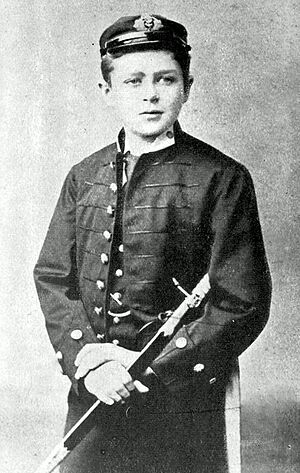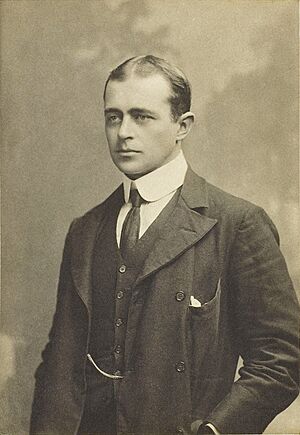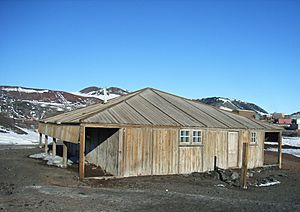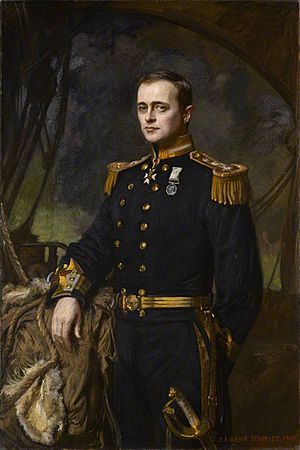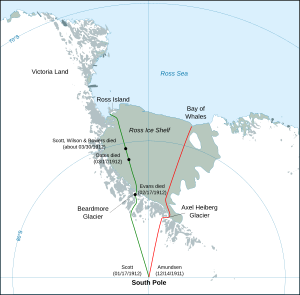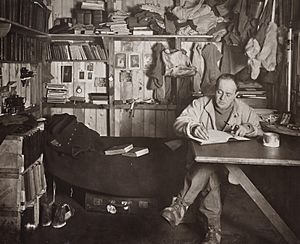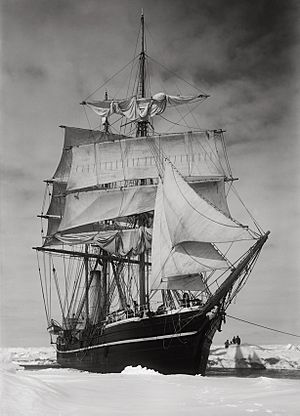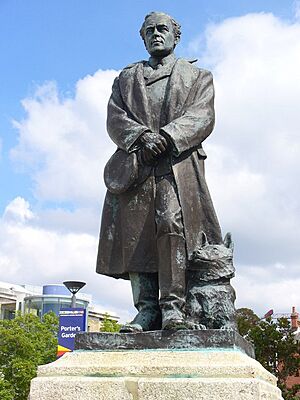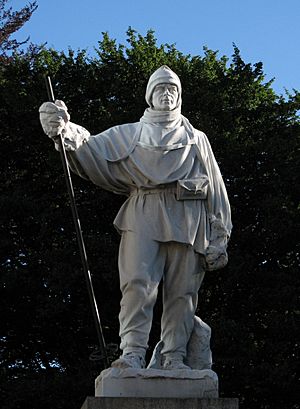Robert Falcon Scott facts for kids
Quick facts for kids
Robert Falcon Scott
|
|
|---|---|
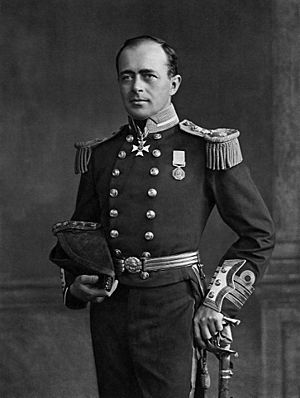
Robert Falcon Scott in 1905
|
|
| Born | 6 June 1868 Plymouth, Devon, England |
| Died | c. 29 March 1912 (aged 43) Ross Ice Shelf, Antarctica |
| Allegiance | United Kingdom |
| Branch | Royal Navy |
| Years of service | 1881–1912 |
| Rank | Captain |
| Expeditions | |
| Awards |
|
| Spouse(s) | |
| Children | Sir Peter Scott |
| Signature | |
Robert Falcon Scott (born June 6, 1868 – died around March 29, 1912) was a British Royal Navy officer and a famous explorer. He led two big trips to the Antarctic (the icy South Pole region). These were the Discovery expedition (1901–1904) and the Terra Nova expedition (1910–1913).
On his first trip, Scott reached a new farthest south point. He also found the Antarctic Plateau, which is a high, flat area where the South Pole is located. On his second trip, Scott and four other men reached the South Pole on January 17, 1912. This was just a few weeks after another explorer, Roald Amundsen, got there first.
Sadly, Scott and his team died on their way back from the Pole. They were about 260 kilometers (162 miles) from their base camp. When their bodies were found, they had the first fossils ever discovered in Antarctica. These fossils were from a tree called Glossopteris. They proved that Antarctica was once covered in forests and connected to other continents.
Before leading the Discovery expedition, Scott was a naval officer. In 1899, he met Sir Clements Markham, who was in charge of the Royal Geographical Society. Scott learned about a planned trip to Antarctica and quickly volunteered to lead it. From then on, his name became linked with exploring the Antarctic.
After his death, Scott was seen as a hero in the UK. Many memorials were built to honor him. Later, some people questioned his leadership. However, in recent years, experts have looked at new information, like the extremely cold weather in March 1912. They also found Scott's written orders for dog teams to meet him. This has led to a more positive view of Scott.
Contents
Family and Early Years
Robert Falcon Scott was born on June 6, 1868. He was the third of six children. His father, John Edward, was a brewer and a judge. The Scott family had a history of serving in the army or navy. Robert's grandfather and four uncles were all in the military.
When Robert was young, his family was comfortable. Following family tradition, Robert and his younger brother, Archie, were expected to join the armed forces. Robert went to a local school and then to Stubbington House School. This school prepared students for the entrance exams to the naval training ship HMS Britannia at Dartmouth. Scott passed his exams and started his naval career in 1881, at just 13 years old.
In July 1883, Scott finished his training on the Britannia. He became a midshipman, ranking seventh out of 26 students. He then sailed to South Africa to join HMS Boadicea. This was the first of many ships he served on as a midshipman.
While serving in the West Indies on HMS Rover, he met Clements Markham. Markham was the Secretary of the Royal Geographical Society. On March 1, 1887, Markham watched Scott's boat win a race. Markham liked to find promising young naval officers for future polar exploration. He was impressed by Scott's intelligence and charm.
In March 1888, Scott passed his exams to become a sub-lieutenant. His career went well, and he was promoted to lieutenant in 1889. In 1891, he took a two-year course to specialize in torpedoes on HMS Vernon. He did very well in this course.
In 1894, Scott learned that his family was having money problems. His father had lost all his savings. This meant Scott needed to earn more money to support his family. Promotion in the Royal Navy was difficult to get, but it would bring more income.
In June 1899, Scott met Clements Markham again in London. Markham was now a knight and the President of the Royal Geographical Society. Scott learned about a new expedition to Antarctica with the ship Discovery. This was a chance for Scott to lead a mission and make a name for himself. A few days later, on June 11, Scott volunteered to lead the expedition.
Discovery Expedition (1901–1904)
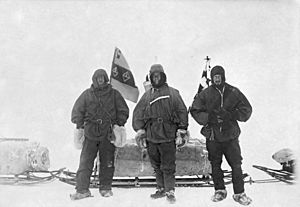
The British National Antarctic Expedition, also called the Discovery Expedition, was a joint effort by the Royal Geographical Society and the Royal Society. Markham had dreamed of this expedition for a long time. He wanted it to be led by the navy, with many naval officers. Scott was chosen to lead, and he was promoted to commander before the ship Discovery sailed for Antarctica on August 6, 1901. King Edward VII, who was very interested in the trip, visited the Discovery and made Scott a member of the Royal Victorian Order.
Most of the 50-person team had no experience in Antarctic or Arctic waters. They also had very little special training. They brought dogs and skis, but many dogs got sick. Still, the dogs' performance impressed Scott. The expedition also faced problems with scurvy, a disease caused by lack of vitamin C.
The expedition had two main goals: scientific research and exploration. One big exploration goal was a long journey south, towards the South Pole. Scott, Ernest Shackleton, and Edward Wilson went on this journey. They reached 82°17′S, which was about 850 kilometers (530 miles) from the Pole. The return trip was very difficult, and Shackleton became very ill and had to leave the expedition early.
In the second year, the team improved their skills. Scott led a journey to the west, where he discovered the Polar Plateau. This journey is considered one of the greatest polar trips ever. The expedition also made important scientific discoveries in biology, zoology, and geology.
At the end of the expedition, two other ships and explosives were needed to free the Discovery from the ice. Scott's strict naval rules caused some tension with the merchant navy crew members.
Between Expeditions
A Popular Hero
The Discovery returned to Britain in September 1904. The expedition had captured the public's imagination, and Scott became a popular hero. He received many honors and medals, including some from other countries. He was promoted to captain and visited Balmoral Castle, where King Edward VII made him a Commander of the Royal Victorian Order.
Scott was very busy for the next few years. He gave many public speeches and wrote a book about the expedition called The Voyage of the Discovery. In January 1906, he went back to his full-time naval career. He continued to move in important social circles.
Disagreement with Shackleton
In early 1906, Scott started asking about funding for another Antarctic expedition. So, he was not happy when Ernest Shackleton announced his own plans. Shackleton wanted to travel to the Discovery's old base at McMurdo Sound and try to reach the South Pole from there.
Scott argued that the area around McMurdo was his "field of work." He felt he had the first right to explore it and that Shackleton should choose a different area. Edward Wilson, who was the zoologist on the Discovery, strongly supported Scott. He believed Scott's rights covered the entire Ross Sea area. Shackleton, however, refused to agree.
To solve the problem, Shackleton finally agreed, in a letter to Scott dated May 17, 1907, to work east of the 170°W line. This meant he would avoid all the places the Discovery team had explored. But in the end, Shackleton could not keep this promise. He couldn't find another good landing spot. So, he set up his base at Cape Royds, which was close to Scott's old Discovery base. Many people in Britain criticized him for this at the time.
Marriage and Family
Scott became well-known in Edwardian society because of his Discovery fame. He met Kathleen Bruce in early 1907 at a lunch party. Kathleen was a sculptor and a socialite. She had studied with famous artists like Auguste Rodin.
Their first meeting was short, but when they met again later that year, they were clearly attracted to each other. Scott was not her only admirer, and his time away at sea made their courtship difficult. However, Scott kept trying, and they were married on September 2, 1908. Their only child, Peter Markham Scott, was born on September 14, 1909. Peter later helped start the World Wide Fund for Nature (WWF).
Terra Nova Expedition (1910–1913)
Getting Ready
Shackleton returned from Antarctica after almost reaching the Pole. This encouraged Scott to plan his second Antarctic expedition. In December 1909, Scott took full command of the British Antarctic Expedition 1910. This trip became known as the Terra Nova expedition, named after its ship, Terra Nova.
The Royal Geographical Society hoped this expedition would focus mainly on science, with reaching the Pole as a secondary goal. However, Scott stated that his main goal was "to reach the South Pole, and to secure for the British Empire the honour of this achievement." Scott was very determined to reach the Pole.
Scott believed that pulling sledges by hand all the way to the South Pole would be too hard. He thought they would need motor vehicles. Since snow vehicles didn't exist yet, his engineer, Reginald Skelton, designed a special track for snow. By mid-1909, Scott realized motors might not get them all the way. So, he decided to also take horses (like Shackleton had used) and dogs. He also planned to use skis.
Cecil Meares, an expert on dogs, went to Siberia to choose the dogs. Scott also asked him to buy Manchurian ponies. Meares was not experienced in buying horses, and most of the ponies he chose were not very strong for the long Antarctic journey. Scott also hired Bernard Day, who had been on Shackleton's expedition, as his motor expert.
First Season Challenges
On June 15, 1910, Scott's ship, Terra Nova, a former whaling ship, sailed from Cardiff, Wales. Scott joined the ship later in South Africa. In October 1910, when he arrived in Melbourne, Australia, Scott received a telegram from Amundsen. It said Amundsen's ship, Fram, was also going to Antarctica. This meant Scott was in a race to the Pole.
The expedition faced problems early on. On its way from New Zealand to Antarctica, the Terra Nova almost sank in a storm. Then, it was stuck in pack ice for 20 days. This was much longer than expected, meaning they arrived late in the season. This left less time to prepare before the Antarctic winter. At Cape Evans, Antarctica, one of the motor sledges was lost. It fell through the sea ice while being unloaded and sank.
Bad weather and weak ponies affected their first trip to set up supply depots. Their main supply point, One Ton Depot, was placed 56 kilometers (35 miles) north of where it was planned. Lawrence Oates, who was in charge of the ponies, told Scott to kill some ponies for food and move the depot farther south. Scott refused. Oates reportedly told Scott, "Sir, I'm afraid you'll come to regret not taking my advice." Four ponies died during this journey from the cold or because they were too slow.
When they returned to base, the team learned that Amundsen was camped with his crew and many dogs at the Bay of Whales. This was 320 kilometers (200 miles) to their east. Scott realized his ponies would not be able to start early enough to compete with Amundsen's dog teams. He also knew that Amundsen's base was 111 kilometers (69 miles) closer to the Pole.
During the winter of 1911, Scott's confidence grew. After a three-man team returned from a winter journey, Scott wrote, "I feel sure we are as near perfection as experience can direct."
Journey to the South Pole
Scott told his entire shore party his plans for the journey south. He said the final team for the Pole would be chosen based on how well they performed during the trip.
The march south began on November 1, 1911. They used motors, dogs, and horses to pull sledges. The plan was for these different groups to support a final team of four men who would make the last push to the Pole. The group heading south became smaller as support teams turned back.
By January 4, 1912, the last two groups of four men reached 87°34′S. Scott then announced his decision: five men would go forward. These were himself, Wilson, Bowers, Oates, and E. Evans. The other three men (Teddy Evans, William Lashly, and Tom Crean) would return to base. The chosen group continued their march. They reached the Pole on January 17, only to find a tent left by Amundsen. Inside was a letter dated December 18. Scott wrote in his diary: "The worst has happened [...] All the day dreams must go [...] Great God! This is an awful place."
The Last March
The disappointed party began the 1,387-kilometer (862-mile) return journey on January 19. Scott wrote that day, "I'm afraid the return journey is going to be dreadfully tiring and monotonous." The team made good progress at first, despite bad weather. They finished the Polar Plateau part of their journey, about 480 kilometers (300 miles), by February 7.
In the following days, as the party went down the 160-kilometer (100-mile) Beardmore Glacier, Edgar Evans's health got much worse. Scott had noticed his decline as early as January 23. A fall on February 4 left Evans "dull and incapable." On February 17, after another fall, he died near the bottom of the glacier. With 640 kilometers (400 miles) still to go across the Ross Ice Shelf, Scott's team faced worsening conditions. The weather got worse, there was a strange lack of fuel at the depots, and they suffered from hunger and exhaustion.
Meanwhile, back at Cape Evans, the Terra Nova arrived in early February. Atkinson decided to unload supplies himself instead of immediately taking dogs south to meet Scott as ordered. When Atkinson finally did leave south for the planned meeting, he found Teddy Evans, who was very sick with scurvy and needed urgent medical help. Atkinson then sent Apsley Cherry-Garrard, who was not good at navigating, only as far as One Ton Depot. This effectively canceled Scott's orders for a meeting farther south.
On the return journey, Scott reached the 82°S meeting point for the dog teams. This was 480 kilometers (300 miles) from Hut Point. He arrived three days early. In his diary on February 27, 1912, he wrote, "We are naturally always discussing possibility of meeting dogs, where and when, etc. It is a critical position." On March 2, Oates began to suffer from frostbite. The team's progress slowed because he could barely help. By March 10, the temperature had dropped unexpectedly to below -40°C (-40°F).
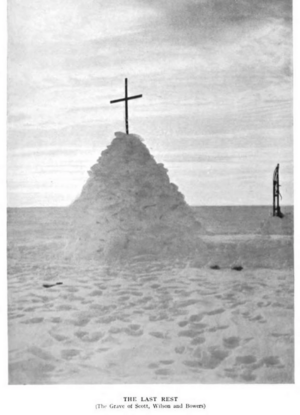
In a farewell letter dated March 16, Scott wondered if he had gone past the meeting point. He started to suspect that the dog teams had not come to meet them. He wrote, "We very nearly came through, and it's a pity to have missed it, but lately I have felt that we have overshot our mark. No-one is to blame and I hope no attempt will be made to suggest that we had lacked support." On the same day, Oates, whose toes were badly frostbitten, walked out of the tent into the blizzard, choosing to die rather than slow down his friends. Scott wrote that Oates's last words were "I am just going outside and may be some time."
After walking 32 kilometers (20 miles) more, even though Scott's own toes were now frostbitten, the three remaining men made their final camp on March 19. They were about 20 kilometers (12.5 miles) short of One Ton Depot. The next day, a fierce blizzard stopped them from moving. For the next nine days, their supplies ran out, and storms continued outside the tent. Scott and his companions wrote their farewell letters. Scott stopped writing in his diary after March 23, except for a final entry on March 29. It ended with the words: "Last entry. For God's sake look after our people." He wrote letters to the mothers of Wilson and Bowers, to important people, and to his own mother and wife.
Scott is believed to have died on March 29, 1912, or possibly one day later. When their tent was found eight months later, the positions of the bodies suggested that Scott was the last of the three to die.

A search party found the bodies of Scott and his companions on November 12, 1912. They also found their records. Their final camp became their grave. The tent roof was lowered over their bodies, and a tall pile of snow was built over it. A cross made from skis was placed on top. Next to their bodies were 16 kilograms (35 pounds) of Glossopteris tree fossils. These were the first fossils ever found in Antarctica. They proved that Antarctica was once warm and connected to other continents.
In January 1913, before the Terra Nova sailed home, the ship's carpenters made a large wooden cross. It had the names of the lost party and a line from Tennyson's poem Ulysses: "To strive, to seek, to find, and not to yield." This cross was put on Observation Hill, overlooking Hut Point, as a lasting memorial.
Scott's Legacy
How He Was Remembered
The world learned about the tragedy when the Terra Nova reached Oamaru, New Zealand, on February 10, 1913. Within days, Scott became a national hero. People felt a strong sense of national pride. The London Evening News asked for his story to be read to schoolchildren. Robert Baden-Powell, who started the Boy Scouts Association, said: "Are Britons going downhill? No! ... Captain Scott and Captain Oates have shown us that."
The survivors of the expedition received honors, including polar medals. Kathleen Scott, Robert's widow, was given the same rank and importance as the widow of a Knight Commander of the Order of the Bath. In 1922, she married Edward Hilton Young. She continued to defend Scott's reputation until she died in 1947.
The Times newspaper reported that both Amundsen and Shackleton were surprised by the disaster. Amundsen reportedly said, "I would gladly forgo any honour or money if thereby I could have saved Scott his terrible death." Scott was a better writer than Amundsen, so the story that spread around the world was mostly Scott's. Amundsen's victory was sometimes seen as unfair by many.
Scott's final request for help for the families of the dead explorers received a huge response. The Scott Memorial Fund collected £75,000. Scott's widow, son, mother, and sisters received £18,000. Wilson's widow received £8,500, and Bowers's mother received £4,500. Edgar Evans's widow, children, and mother received £1,500.
In the 12 years after the tragedy, more than 30 monuments and memorials were built in Britain alone. These included Scott's sledging flag in Exeter Cathedral and the founding of the Scott Polar Research Institute at Cambridge. Many more memorials were set up around the world, including a statue in Christchurch, New Zealand, sculpted by his widow.
The Museum of Oxford displays some of his personal items. These include a marmalade tin given to him by an Oxford businessman, which was found at the site of his death.
Changing Views Over Time
Scott's good reputation lasted for a long time, even after the 50th anniversary of his death. In 1948, the movie Scott of the Antarctic was released. It showed the team spirit of the expedition and the harsh Antarctic environment. However, it also included scenes where Scott regretted not taking only dogs, remembering Nansen's advice.
In 1966, Reginald Pound wrote a book about Scott. He was the first writer to see Scott's original diary. Pound showed some of Scott's personal weaknesses, but still praised him as a hero. Another critical book, Scott's Men by David Thomson, came out in 1977. Thomson felt Scott was not a great man until near the end. He described Scott's planning as "haphazard" and his leadership as lacking foresight. By the late 1970s, people started to question Scott's personality and methods.
In 1979, Roland Huntford published a book called Scott and Amundsen. In this book, Scott was shown as a "heroic bungler." Huntford's idea became very popular. After his book, several other negative books about Captain Scott were published. Francis Spufford wrote in 1996 about "devastating evidence of bungling," saying that "Scott doomed his companions." Travel writer Paul Theroux called Scott "confused and demoralised... an enigma to his men, unprepared and a bungler." As Scott's reputation went down, Shackleton's reputation went up. In a 2002 poll in the UK, Shackleton was ranked 11th among the "100 Greatest Britons," while Scott was 54th.
However, in the 21st century, opinions have started to shift back in Scott's favor. This is called a "revision of the revisionist view." In 2001, meteorologist Susan Solomon wrote The Coldest March. She argued that the extreme cold weather in February and March 1912 was the main reason for Scott's party's fate. She saw the criticism of Scott as a "Myth of Scott as a bungler."
In 2005, David Crane published a new book about Scott. He concluded that Scott is perhaps the only person in polar history who has been so completely hidden by legends.
In 2012, Karen May discovered that Scott had given written orders for dog teams to meet his returning party. This was different from what Huntford had claimed in 1979, who said Scott only gave these orders by word of mouth. May's discovery showed that Huntford's idea was based on a mistake.
Scott's expedition has also been featured in plays and novels. Terra Nova, a 1977 play by Ted Tally, tells the story. Beryl Bainbridge's 1991 novel The Birthday Boys also gives a fictional account of the expedition.
See also
 In Spanish: Robert Falcon Scott para niños
In Spanish: Robert Falcon Scott para niños
- Amundsen–Scott South Pole Station, a permanent base at the South Pole
- Heroic Age of Antarctic Exploration, the period of exploring Antarctica
- List of solved missing person cases


